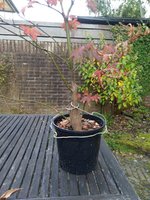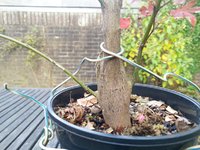Bnana
Chumono
I made an air layer from a Japanese maple in my garden. It worked well and the layer had a good start with plenty of roots.
Now the question arises how to develop it. I have no experience with maples. I removed some large branches when I separated it, that's obvious I guess. The trunk has a 4.5 cm diameter.
It doesn't have a lot of movement but it has taper. So I'm thinking about a fat little upright that can develop a nice crown and nebari over the coming years.
But now how and where to cut? Leave the two lower branches to fasten the trunk and cut them back later? Where should I chop?
Hoping for some input from people with a better trained eye.
The ugly wire is just to keep it stable after removing it from the tree.





Now the question arises how to develop it. I have no experience with maples. I removed some large branches when I separated it, that's obvious I guess. The trunk has a 4.5 cm diameter.
It doesn't have a lot of movement but it has taper. So I'm thinking about a fat little upright that can develop a nice crown and nebari over the coming years.
But now how and where to cut? Leave the two lower branches to fasten the trunk and cut them back later? Where should I chop?
Hoping for some input from people with a better trained eye.
The ugly wire is just to keep it stable after removing it from the tree.







